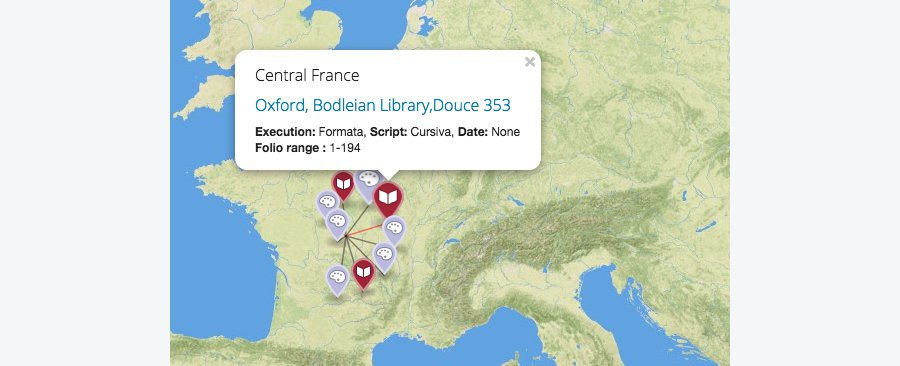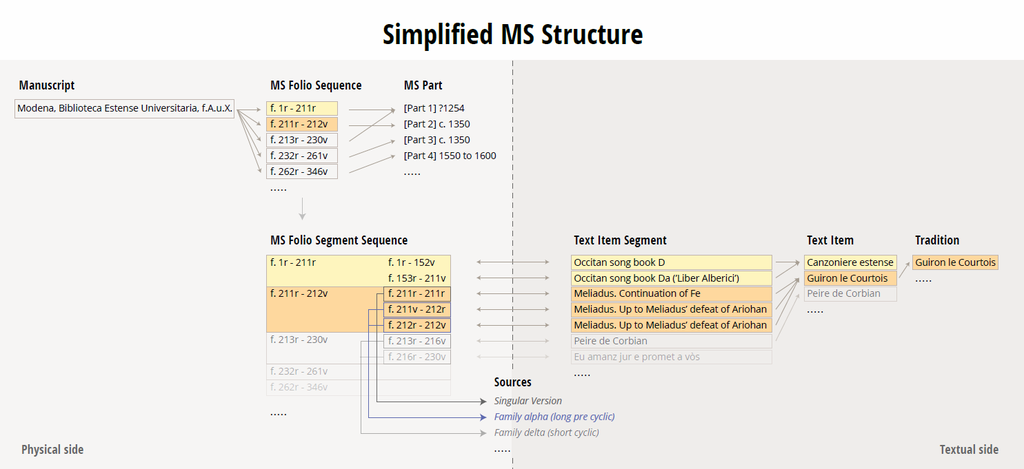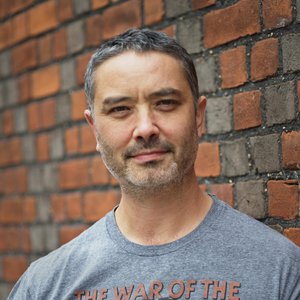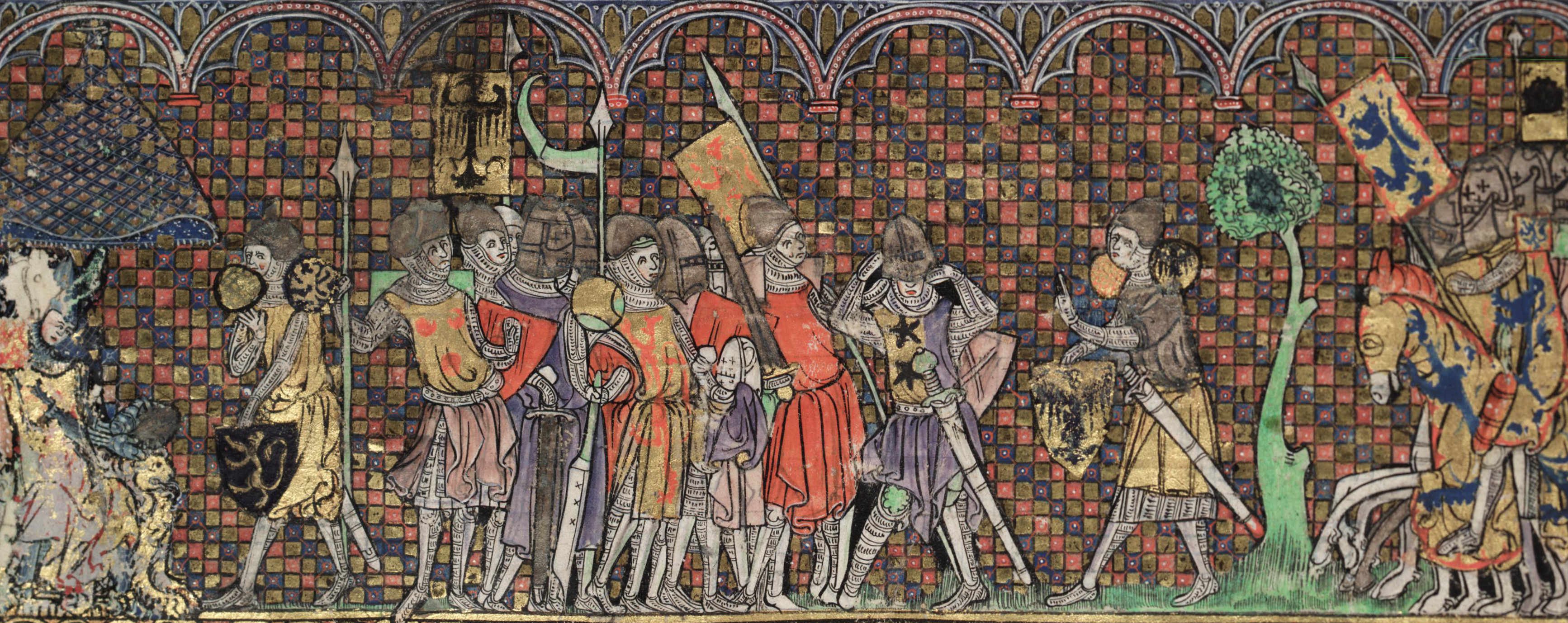From a starting point of characterising and classifying the variation in six core literary traditions, we were able to evaluate the relationships, ancestry and provenance of hundreds of manuscripts, providing a window on the European continent at a time when the French language was widely used by communities who didn’t identify themselves as French.
Background
KDL worked closely with the project investigators to develop a customised data model of medieval manuscripts which allowed for edge cases whilst maintaining a coherent and consistent structure. The database enables a researcher to browse corpora by textual content, to identify hybrid MSS, investigate provenance and transmission, characterise by physical features and to see distributions of MSS geographically.
Working with colleagues in the King’s Digital Lab is not simply about getting technical support. Building digital resources requires a clarity of thinking that is qualitatively different from most conceptual frameworks in the Humanities, so you are pushed to think about your objectives and about the categories you are using with new rigourProfessor Simon Gaunt
King's College London
Using an innovative classification of textual traditions, identifying the source and version of the smallest narrative components, the project defined a DNA sequence for each MS which allows researchers to directly map and model the ancestry or descendants of a manuscript. Chains of similar content can be used quickly identify related manuscripts and open up new directions of investigation. This work has lead PI Simon Gaunt onto a follow up project with KDL, “The Values of French”
The most exciting aspect of our ongoing project The Values of French is the prospect of using digital technology to undertake discourse analysis and of linking linguistic and lexical data to parallel editions of different versions of the same textProfessor Simon Gaunt
King's College London
The investigators and KDL discovered together the potential of opening up their subject to a wide audience. By allowing the website visitor to access the research through a number of different interfaces, the project maximises accessibility and encourages understanding of the corpora from a variety of perspectives.

Exploring the manuscripts through mapping their parts and history
Developing the underlying data structure, which coalesced through a series of reviews and product iterations guided by a strong and focused partnership between the lead developer and Dr. Jane Gilbert, was key to the success of the project. This solid base later enabled us not only to build the originally envisioned web resource, but also freed us to create new visualisations in full confidence that the underlying data model offered the greatest range of options.

The MFLC database structure (simplified presentation)
How we worked
-
Clarifying
The first task for KDL was to fully engage with the subject matter and understand the complexities of the research goal.
-
Conceptualising
The developer help regular meetings with one of the co-investigators to constantly refine the data models for both the physical manuscripts and for the textual elements of the corpora. This linking of the "actual" to the "conceptual" was key to the project success.
-
Building
From solid foundations and with a robust framework in place, the research team were able to record data in a structurally sound way and were still able to capture the nuances they needed.
-
Visualising
With a completed dataset, KDL enabled users to access the research in a number of ways, from simple lists, to faceted searches, spatial queries and even to create a purely conceptual criteria based on any combination textual elements.
The Team
-

Neil Jakeman
Lead developer
MFLC was a very rewarding project to work on with a passionate team of investigators. The project topic really opened up for me with and I too became immersed in the minutiae of these old manuscripts. The most exciting projects for us at KDL are the ones where we take away new knowledge as much as we contribute to the technical output.
-

Dr. Jane Gilbert
Co-investigator
Working with King's Digital Lab was a genuinely collaborative experience. It is not easy to stage a successful encounter between digital specialists and scholars in traditional disciplines (in my case, medieval French literary studies). This is especially the case when the task is to design a digital engine whose inputs as well as outputs will shape definitively a research project still in its early stages. It is necessary to think ahead imaginatively about possible outcomes and pitfalls, and in doing so to bring together the knowledge and experience of specialists on both sides - or often, of multiple aspects within each side. I've been very happy to know and work with several digital humanities specialists at KCL in the course of the AHRC-funded Medieval Francophone Literary Culture Outside France project, but the crucial encounter was with Neil Jakeman, then recently appointed as a programmer with the DH department. Communication was the key. Above all, Neil listened, and showed himself to be a generous and open-minded interlocutor. He asked intelligent, curious questions that required us to reach for new levels of articulation and clarity, checked understanding without egocentricity, and responded creatively. Together we developed a model (based around the Star Wars movies!) for exploring materials and ideas that were, in different ways, new to us both. The database that we designed and that Neil built was, in programming terms, complex and innovative; its implementation expands the analytical possibilities available to textual and manuscript scholars. Neil's suggestions showed his grasp of the principles as well as the materials involved in the project. This was not only crucial technically, but also contributed very significantly to the project's intellectual success and to the usefulness of the final database.,www.medievalfrancohone.ac.uk When in later stages other members of the Lab were brought in, Neil remained involved. He was generous with his time and engagement right up until the final stages, happy to talk about the implementation of big ideas as well as to tinker with minor bugs. It is largely thanks to his input that the database now allows scholars to explore dynamically the interface between manuscripts and texts in unprecedented ways.
-

Professor Simon Gaunt
Principal Investigator
Working with colleagues in the King's Digital Lab is not simply about getting technical support. Building digital resources requires a clarity of thinking that is qualitatively different from most conceptual frameworks in the Humanities, so you are pushed to think about your objectives and about the categories you are using with new rigour. You also have to explain what you are doing in simple, non-technical terms and answer sometimes unexpected questions about it. The process is both enriching and challenging. And what is most exciting is that it opens up new possibilities and questions about your own research. With Medieval Francophone Literary Culture, thanks to Neil, we were able to build a tool for understanding and mapping medieval textual traditions on the basis of large amounts of data about manuscripts that went way beyond previous descriptive and undynamic databases. The most exciting aspect of our ongoing project The Values of French is the prospect of using digital technology to undertake discourse analysis and of linking linguistic and lexical data to parallel editions of different versions of the same text. Paul Caton’s patient help with developing the right XML tagging system for this and with setting up the framework has been key to the development of the project.







